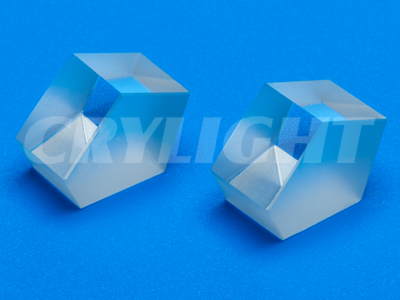 CRYLIGHT社 Prism
CRYLIGHT社 Prism
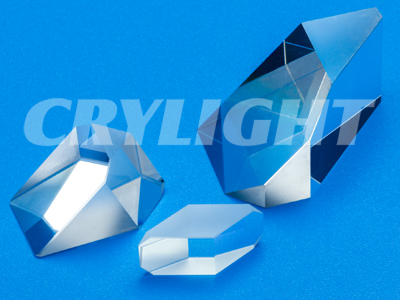
各モデルの抜粋仕様を下記から確認いただけます。
Fused Silica WedgeBK7 WedgeAnamorphic PrismDispersive PrismDove PrismCorner Cube RetroreflectorFused Silica Right Angle PrismBK7 Right Angle PrismBeamSplitter Penta PrismPenta Prism
Fused Silica Wedge

Features
The prism with the plane surfaces at slight angles(which divert the paths of light through angles by refraction instead of reflection) are called optical wedges. Optical wedges are used in fire control and optial alignment instruments; they may be used where the angle of deviation required is a matter of fractions of seconds. The angle at which a wedge diverts a path of light depends on the angle between the entrance and emergence faces and the index of refraction of the glass.
Specifications
Specifications: | Material: | Fused Silica |
| Design Wavelenght : | 308nm n=1.48575 |
| Diameter Tolerance: | +0.0, -0.1mm |
| Thickness Tolerance: | ±0.2mm |
| Surface Quality: | 60/40 |
| Wedge Angle: | ±1 minute |
| Flatness: | λ/4 @632.8nm |
| Bevel: | <0.25mm X 45° |
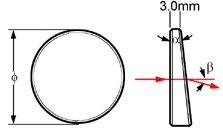
| Part No. | φ(mm) | β (mm) | α (mm) |
| WED2-101 | 25.4 | 1° | 2°4′ |
| WED2-102 | 25.4 | 2° | 4°7′ |
| WED2-103 | 25.4 | 4° | 8°14′ |
| WED2-104 | 25.4 | 6° | 12°21′ |
BK7 Wedge
Features
The prism with the plane surfaces at slight angles(which divert the paths of light through angles by refraction instead of reflection) are called optical wedges. Optical wedges are used in fire control and optial alignment instruments; they may be used where the angle of deviation required is a matter of fractions of seconds. The angle at which a wedge diverts a path of light depends on the angle between the entrance and emergence faces and the index of refraction of the glass.
Specifications: | Material: | BK7 |
| Design Wavelenght : | 633nm n=1.51467 |
| Diameter Tolerance: | +0.0, -0.1mm |
| Thickness Tolerance: | ±0.2mm |
| Surface Quality: | 60/40 |
| Wedge Angle: | ±1 minute |
| Flatness: | λ/4 @632.8nm |
| Bevel: | <0.25mm X 45° |

| Part No. |
φ(mm) |
β (mm) |
α (mm) |
| WED1-101 |
25.4 |
1° |
1°57′ |
| WED1-102 |
25.4 |
2° |
3°53′ |
| WED1-103 |
25.4 |
4° |
7°46′ |
| WED1-104 |
25.4 |
6° |
11°39′ |
Anamorphic Prism
Features
Anamorphic Prism Pairs are used to transform elliptical laser diode beams into nearly circular beams. Because the prisms are set near Brewster’s angle and with AR coating customized to the angle of the index SF11 glass, an average throughput of 95% can be achieved.
Specifications: | Material: | SF11 |
| Diameter Tolerance: | +0.0/-0.2mm |
| Clear Aperture: | >80% |
| Flatness: | λ/2 @ 633nm |
| Theta: | θ= 29°27’±30″ |
| Surface Quality: | 60/40 |
| Coating: | MgF2 on perpendicular surface |
| Part No. | A (mm) | B (mm) | C (mm) |
| ANP0-101 | 12 | 12 | 8.5 |
Dispersive Prism
Features
Equilateral dispersing prisms are used for wavelength separation applications. The three sides are of equal length. A light ray is twice refracted passing through the prism with total deviation denoted by qd in the figure below. Deviation is a function of refractive index, and hence wavelength. Angular dispersion Dqd is the difference in deviation for light rays having different wavelengths and varies with prism orientation.
Specifications
Specifications: | Material: | BK7 |
| Diameter Tolerance: | +0.0/-0.2mm |
| Angle Tolerance: | ±3 arc minutes |
| Flatness: | λ/4 @ 632.8nm |
| Surface Quality: | 60/40 |
| Clear Aperture: | >80% |
| Bevel: | <0.2-0.5mm X 45° |
| Coating: | Uncoated |
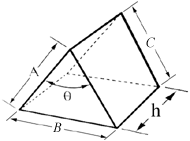
| Part No. |
A=B=C(mm) |
H(mm) |
| DSP1-101 |
15 |
15 |
| DSP1-102 |
25 |
25 |
| DSP1-103 |
30 |
30 |
Dove Prism

Features
Dove prism is a type of reflective prism which is used to invert an image. Dove prisms are shaped from a truncated right-angle prism. A beam of light entering one of the sloped faces of the prism undergoes total internal reflection from the inside of the longest (bottom) face and emerges from the opposite sloped face. Images passing through the prism are flipped, and because only one reflection takes place, the image’s handedness is changed to the opposite sense.
Specifications
Specifications: | Material: | BK7 |
| Diameter Tolerance: | +0.0/-0.2mm |
| Angle Tolerance: | ±3 arc minutes |
| Flatness: | λ/2 @ 632.8nm |
| Surface Quality: | 60/40 |
| Clear Aperture: | >80% |
| Bevel: | <0.2-0.5mm X 45° |
| Coating: | Uncoated |

| Part No. | A(mm) | B(mm) | h(mm) |
| DVP1-101 | 21.1 | 5 | 5 |
| DVP1-102 | 42.3 | 10 | 10 |
| DVP1-103 | 63.4 | 15 | 15 |
Corner Cube Retroreflector
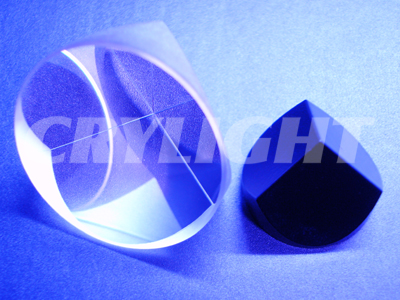
Features
Corner Cube Retroflectors are used to reflect light beam back to the direction that it comes from. The reflected beam is always parallel to the incident beam, and it travels in the reverse direction of the incident beam. This holds true regardless of the angle of incident beam. The beam reflection is achieved either through total internal reflection or by a mirror coating on the rear surfaces of the retro-reflector.An incident beam, filling the effective aperture, is reflected exactly back on itself. Protective AL coating can be applied to the rear reflecting surfaces to avoid total internal reflection failure at high incident angle.
Specifications: | Material: | BK7 |
| Diameter Tolerance: | +0.0/-0.2mm |
| Deviation: | 180°±3 arc seconds |
| Flatness: | λ/4 on big surface,λ/10 on other surfaces |
| Surface Quality: | 60/40 |
| Wavefront Distortion: | λ/4 @ 632.8nm |
| Clear Aperture: | >80% |
| Bevel: | <0.2-0.5mm X 45° |
| Coating: | Uncoated |
| Part No. | F (mm) | h (mm) |
| CCR1-101 | 15 | 11.3 |
| CCR1-102 | 25.4 | 19 |
| CCR1-103 | 38 | 28.5 |
| CCR1-104 | 50.8 | 37.5 |
Fused Silica Right Angle Prism
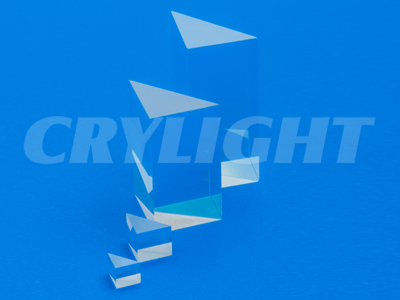
Features
Right-Angle Prism is used as a mirror to deviate light through 90 degree, and also as a retroreflector to deflect light through 180 degree by total internal reflection.
Specifications:
| Material: |
Fused Silica |
| Diameter Tolerance: |
+0.0/-0.2mm |
| Angular Tolerance: |
see the table as follow |
| Flatness: |
λ/2 @ 632.8nm |
| Surface Quality: |
60/40 |
| Clear Aperture: |
>80% |
| Bevel: |
<0.25mm X 45° |
| Coating: |
Uncoated |

| Deminsion (mm) | 3 Min. Deviation | 1 Min. Deviation | 30 Sec. Deviation |
| Part No. | Part No. | Part No. |
| A=B=C=10.0 | RAP2-101 | RAP2-201 | RAP2-301 |
| A=B=C=12.7 | RAP2-102 | RAP2-202 | RAP2-302 |
| A=B=C=25.4 | RAP2-103 | RAP2-203 | RAP2-303 |
BK7 Right Angle Prism
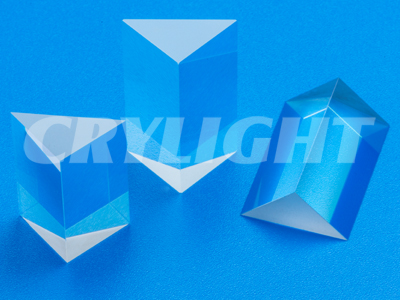
Features
Right-Angle Prism is used as a mirror to deviate light through 90 degree, and also as a retroreflector to deflect light through 180 degree by total internal reflection.
Specifications: | Material: | BK7 |
| Diameter Tolerance: | +0.0/-0.2mm |
| Angular Tolerance: | see the table as follow |
| Flatness: | λ/2 @ 632.8nm |
| Surface Quality: | 60/40 |
| Clear Aperture: | >80% |
| Bevel: | <0.25mm X 45° |
| Coating: | Uncoated |

| Deminsion (mm) |
3 Min. Deviation |
1 Min. Deviation |
30 Sec. Deviation |
| Part No. |
Part No. |
Part No. |
| A=B=C=2.0 |
RAP1-101 |
RAP1-201 |
RAP1-301 |
| A=B=C=3.2 |
RAP1-102 |
RAP1-202 |
RAP1-302 |
| A=B=C=5.0 |
RAP1-103 |
RAP1-203 |
RAP1-303 |
| A=B=C=10.0 |
RAP1-104 |
RAP1-204 |
RAP1-304 |
| A=B=C=12.7 |
RAP1-105 |
RAP1-205 |
RAP1-305 |
| A=B=C=15.0 |
RAP1-106 |
RAP1-206 |
RAP1-306 |
| A=B=C=20.0 |
RAP1-107 |
RAP1-207 |
RAP1-307 |
| A=B=C=25.4 |
RAP1-108 |
RAP1-208 |
RAP1-308 |
| A=B=C=30.0 |
RAP1-109 |
RAP1-209 |
RAP1-309 |
BeamSplitter Penta Prism
Features
By adding a wedge and with partial reflective coating on first reflective surface, Penta Prism can be used as Beamsplitter. We supply Beamsplitter Penta Prism with standard Transmission/reflection (T/R) ratio of 20/80, 50/50. Others T/R ratio is available upon request.
Beamsplitter penta prism is a penta prism glued with a wedge on a reflecting surface. It is used to divide an incident beam into two separate beams: Transmission(T) and reflection(R). The image is neither inverted nor reversed.
Specifications
Specifications:
| Material: |
BK7 |
| Diameter Tolerance: |
±0.2mm |
| Angular Tolerance: |
see the table as follow |
| Flatness: |
λ/2 | λ/4 @ 632.8nm |
| Surface Quality: |
60/40 |
| Reflectivity |
R>95% per face @400-700nm |
| T/R |
20/80±5 or 50/50±5 |
| Clear Aperture: |
>80% |
| Bevel: |
<0.25mm X 45° |
| Coating: |
* S1&S2&S5: Single layer MgF2 coating |
| * S3: Partial reflective coating |
| * S4: Aluminized and painted black |
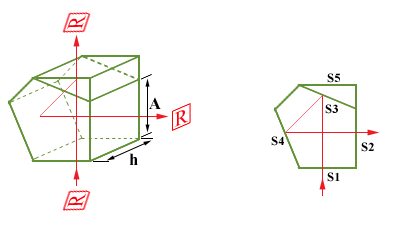
| Size(mm) | 30 Sec. Deviation | 10 Sec. Deviation |
| A x h | Part No. | Part No. |
| 7 x 6 | BPP1-203 | BPP1-303 |
| 10 x 10 | BPP1-204 | BPP1-304 |
| 15 x 15 | BPP1-205 | BPP1-305 |
| 20 x 20 | BPP1-206 | BPP1-306 |
Penta Prism
Features
Penta Prism is a five-sided prism containing two reflecting surfaces at 45 to each other, and two refracting faces perpendicular to the entering and emerging beams. The deviation angle of 90deg is thus independent of the orientation of the prism, making it especially important in applications in which the prism orientation cannot be precisely controlled. Due to the geometry that total internal reflection cannot be used, the reflecting surfaces must be coated with a metallic or dielectric coating. The standard Penta Prism reflecting surfaces are coated with aluminum or enhanced aluminum. The coated surfaces can be painted black .
The penta prism is a five-sided prism. It reflects light rays through a 90° angle by two reflections and does invert or revert the image. The reflecting surfaces are aluminized. Slight movement of the prism does not affect the true right angle at which light rays are reflected. It also shortens the optical path length of an instrument.
Specifications
Specifications: | Material: | BK7 |
| Diameter Tolerance: | +0.0, -0.2mm |
| Angular Tolerance: | see the table as follow |
| Flatness: | λ/2 @ 632.8nm |
| Surface Quality: | 60/40 |
| Clear Aperture: | >80% |
| Bevel: | <0.25mm X 45° |
| Coating: | * S1&S2: Single layer MgF2 coating |
| * S3&S4: Aluminized and painted black |

Deminsion(mm)
Axh |
30 Sec. Deviation |
10 Sec. Deviation |
| Part No. |
Part No. |
| 7×5 |
PTP1-201 |
PTP1-301 |
| 7×6 |
PTP1-202 |
PTP1-302 |
| 10×10 |
PTP1-203 |
PTP1-303 |
| 15×15 |
PTP1-204 |
PTP1-304 |
| 20×20 |
PTP1-205 |
PTP1-305 |
| 30×30 |
PTP1-206 |
PTP1-306 |
 CRYLIGHT社 Prism
CRYLIGHT社 Prism















